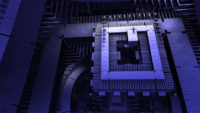Quantum Computing in Silicon Achieves 99 Percent Accuracy
January 26, 2022
Australian researchers have had a breakthrough in quantum computing, proving that nearly error-free processing is possible, which could lead to the possibility of silicon-based quantum machines whose manufacture could be compatible with today’s semiconductor manufacturing technology. “Our operations were 99 percent error-free,” said University of New South Wales (UNSW Sydney) professor Andrea Morello, who led the work with partners in the U.S., Japan, Egypt, and at the University of Technology Sydney (UTS) and the University of Melbourne. “When the errors are so rare, it becomes possible to detect them and correct them when they occur.”
Morello’s paper is one of three published last week in Nature confirming that “robust, reliable quantum computing in silicon is now a reality,” according to SciTech Daily.

“This shows that it is possible to build quantum computers that have enough scale, and enough power, to handle meaningful computation,” Morello said in an announcement on the UNSW Sydney website. The team’s goal is building a universal quantum computer that will be appropriate for general use.
The universal approach, which utilizes a gate model, is one of two basic types of quantum computer. The other type, quantum annealers, were the first to market in 2011, but can only be used for one function. A step up from annealers are the so-called “analog simulators,” which utilize about 100 qubits.
In 2020, IBM, Google, Microsoft, Rigetti, Honeywell and IonQ were developing analog quantum computers, and there seemed to be a general belief that the approach would result in the first quantum computers that could both exponentially outperform today’s computers and be brought to market on a broad scale. Last year, the buzz shifted to the universal approach, which requires in excess of 100,000 qubits and is still a long way off.
In October, IBM claimed to be the first company to crack 100 qubits with its Eagle processor. In May, Google shared with The Wall Street Journal “plans to spend several billion dollars to build a quantum computer by 2029 that can perform large-scale business and scientific calculations without errors,” then wrote in a company blog post that to reach its goal it will build a machine with “1,000,000 physical qubits that work in concert inside a room-sized error-corrected quantum computer.”
The findings by UNSW and associates will likely help Google on its journey. The group seems to have come up with a novel approach to achieving accuracy out of notoriously unstable qubits, achieving one-qubit operation fidelity up to 99.95 percent and two-qubit fidelity of 99.37 percent in a three-qubit system comprised of an electron and two phosphorous atoms, introduced into silicon via ion implantation and entangled via a nuclear spin.
“If you have two nuclei that are connected to the same electron, you can make them do a quantum operation,” said Dr. Mateusz Madzik, one of the lead experimental authors. “While you don’t operate the electron, those nuclei safely store their quantum information [and] you have the option of making them talk to each other via the electron, to realize universal quantum operations that can be adapted to any computational problem,” Madzik explained in the UNSW statement.
Using an electron to wrap around the two nuclei of phosphorus atoms was a breakthrough, as detailed in the Nature paper. For while nuclear spins provide exceptionally good qubits, due to their extreme isolation from the environment, that feature made it difficult for the qubits to interact and perform quantum logic operations.
Morello had previously used nuclear spins to preserve quantum information in silicon for 35 seconds. “In the quantum world, 35 seconds is an eternity,” Morello said. “To give a comparison, in the famous Google and IBM superconducting quantum computers the lifetime is about a hundred microseconds — nearly a million times shorter.” However, their extreme isolation prevented the qubits from interacting with each other, making it seemingly impossible to perform actual computations.
“This really is an unlocking technology,” explained Dr. Serwan Asaad, another lead experimental author. “The nuclear spins are the core quantum processor. If you entangle them with the electron, then the electron can then be moved to another place and entangled with other qubit nuclei further afield, opening the way to making large arrays.”
The upshot, according to the UNSW announcement, is “semiconductor spin qubits in silicon are well-placed to become the platform of choice for reliable quantum computers. They are stable enough to hold quantum information for long periods and can be scaled up using techniques familiar from existing advanced semiconductor manufacturing technology.”

No Comments Yet
You can be the first to comment!
Sorry, comments for this entry are closed at this time.